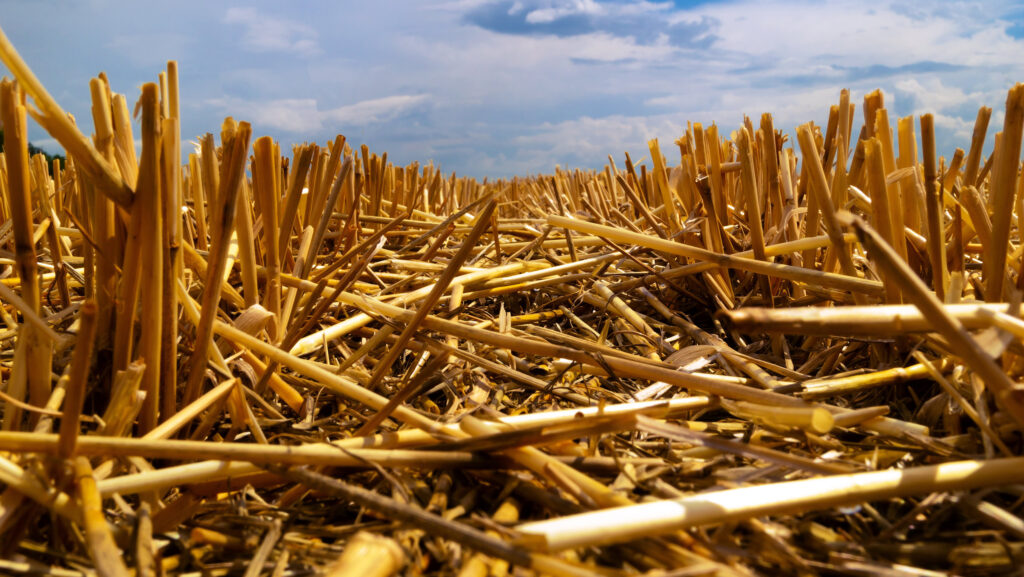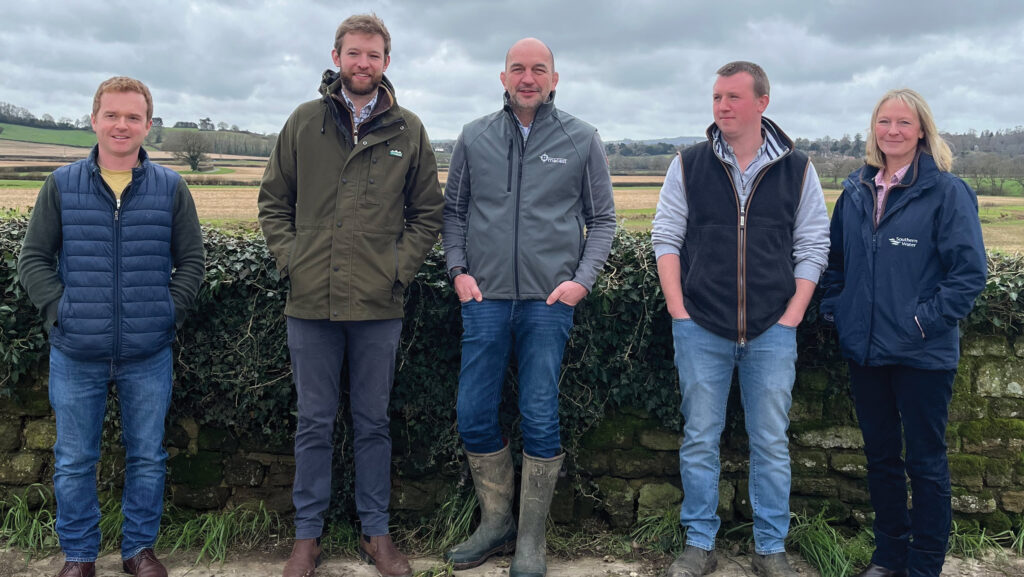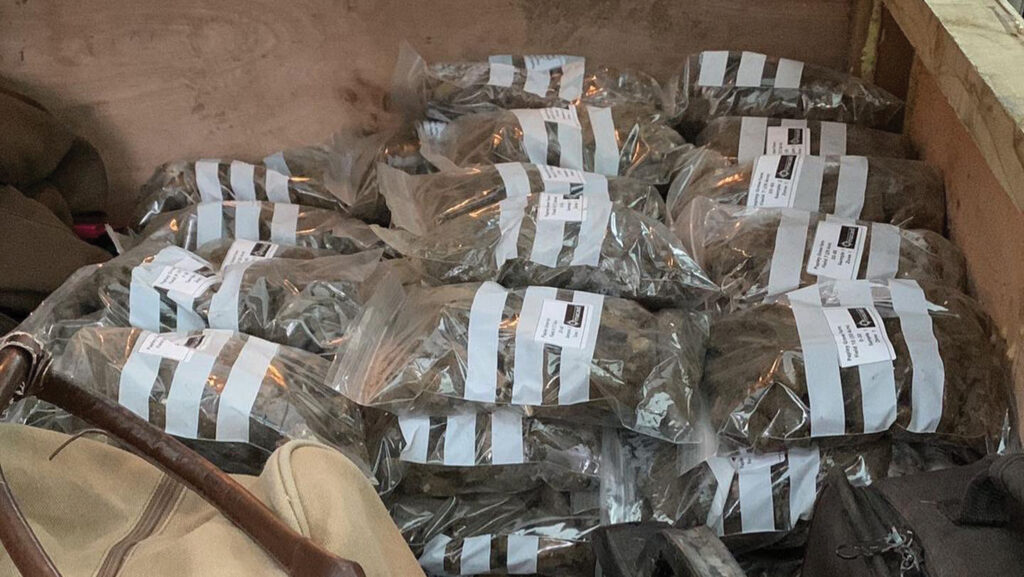Sussex soil project aims to increase organic matter
 © Tim Scrivener
© Tim Scrivener The impact of soil type and land use on the ability of farms to improve soil organic matter levels is being investigated in a five-year project funded by Southern Water, with six farm sites providing the variety of soil types and farming systems.
After the first year, results showed a 0.1% increase in organic matter stored an additional 4.7t/ha of carbon, highlighting that small improvements made every year can help farmers hit net zero targets.
See also: Why cover crops and reduced tillage is key to soil health
The Soil Carbon Project started in 2022 with accurate measurements, so that a baseline was established and the most appropriate management decisions could be made about improving soil health and protecting water quality.

(From left to right) Jeremy Wray, Stephen Woodley, Mark Chandler, Barney Tremaine and Zoe Fothergill © Louise Impey
Soil carbon
In arable systems, light soils typically hold 30t/ha of soil carbon in the top 0-30cm and heavy soils 60t/ha. Well-managed, long-term grassland may have 100t/ha.
As participating farmer Mark Chandler explains, giving farmers the data about what’s happening to soils helps with their pursuit of productive and environmental goals, for the best future outcome.
“This project isn’t being done to monetise the soil’s carbon content or to make decisions about taking land out of production, but to develop the soil resilience needed for the long term,” he says.
“Rigorous soil analysis and recognised testing methodologies are behind it, not modelling or predictions.”
On Keyfox Farm, an arable farm on a 15-year farm business tenancy (FBT) that is part of G Chandler Farming Ltd, the results have shown that soil texture is variable and clay content ranges from 25-40%, with soil organic matter varying from 1.2-4%.
Slightly below the average for this soil type, it reflects the long-term arable management in place.
Incorporating straw and residues, using catch and cover crops, reducing tillage and adding organic matter with biosolids are all practices which would help improve these figures, he notes.
“We’re doing most of these already. As the group is discovering, increasing soil organic matter is a long-term biological process.”
Testing and measuring
To get the required accuracy, precision service Omacast – which was set up by Mark and Stephen Woodley – has been measuring allocated areas of the farms, interpreting the results and advising on changes, with the project now moving into its third year.
All the farmers had 40ha measured in the first year, while a total of 420ha has been scanned to date across 46 fields and 16 different soil types.
The first step was to confirm fields and land uses, before a Veris U3 soil scanner was used to identify soil type and variability by electronic conductivity, helping establish the soil sampling zones needed in each field.
The next stage was to take the soil samples from the identified zones, with 16 cores a zone being GPS-logged, using a Wintex 2000 automatic soil sampler.
They were taken at two depths, 0-30cm and 30-60cm.
The final stage was to calculate the soil organic matter, using the Dumas method, so that the carbon stock could be revealed. The findings have since been verified by Niab.
In 2023, after some discussion among the group, carbon auditing was introduced with the help of Trinity. “We’re getting our ducks in a row,” explains Mark.

© Omacast
What is Omacast?
Developed by farmers for farm use, Omacast is a precision measuring, mapping and interpreting service which shows what’s going on in the soil.
It gives a baseline measurement of current carbon stocks, which can be used to plan changes in farming practice that directly influence carbon capture and soil health.
Although the soil’s clay content influences how much carbon can ultimately be held, all soils benefit from the regular addition of organic inputs and the presence of actively growing roots, explains Stephen Woodley of S Woodley Crop Services and one of the founders of Omacast Ltd.
“Soil type is the key,” he says. “It is harder to build up soil organic matter in light sandy soils, but there are good reasons for doing so – reducing the risk of slumping and capping is just one of them.”
Omacast is looking to expand its service to other areas, he confirms.
It costs £56/ha but that can be spread over a number of years and the forthcoming Sustainable Farming Incentive (SFI) precision farming payment of £27/ha can be used to part-fund it.
Southern Water involvement
The Western Rother catchment in Sussex experiences many of the challenges that the wider water industry is grappling with and are often linked to farming practices, reports Zoe Fothergill of Southern Water.
Soil erosion, sediment loads and contaminants in water are among those, along with others including biodiversity decline and the need to meet regulatory requirements.
“These are all things that have to be addressed,” says Zoe.
“We prefer to do that using a collaborative approach, working with farmers to understand any practical difficulties, before looking at ways to improve current practices and prevent any further deterioration.”
That means getting local engagement so the company supports numerous projects in the area and has been sponsoring the Soil Carbon Project for the past two years.
“We know improving soil health helps with water infiltration and water-holding capabilities, so the data that this project is providing is very valuable,” she points out.
“We can see which of the approaches are working and share the learnings more widely.”

© Omacast
Case studies
Jeremy Wray, Marshalls Farm
Running an organic dairy farm, Jeremy Wray farms in partnership with his wife Kate at Kirdford and has been willingly participating in the project with Southern Water.
The results to date show that his long-term dairy fields have some of the highest soil organic matter contents of the group, even those that have been ploughed in the past two years.
An Arla supplier, Jeremy gets financially rewarded for improving his carbon footprint and is benchmarked against others, so having this type of data is helpful.
“It’s for our use only and it highlights parts of the farm where further improvements are possible.”
Growing as much forage as possible for the dairy herd, the farm has both herbal leys for grazing and clover silage leys, so there are very few times of the year when soil is bare.
“We are doing our bit to enhance soil structure, water retention and nutrient cycling in a resilient farming system,” he says. “It must benefit the catchment too.”
Barney Tremaine, Cowdray Home Farms
Farm manager Barney Tremaine, who oversees arable, beef and dairy enterprises across 1,280ha, points out that there is no one else providing the level of soil data that he is receiving from the project.
Having seen the biggest improvement in the top 30cm of soil, he is keen to understand more about what happens to carbon stocks lower down the soil profile, and what he could do to influence them at depth.
Barney views Omacast as a good business tool which will increase the farm’s profitability and improve its environmental impact, especially when it comes to marginal land.
“It would be financially restrictive for us to do this work for ourselves.”
An M&S supplier, the farm’s dairy has been subjected to a full carbon audit and has been set targets for the next five years.
“The retailer wants to see a 70% reduction in our carbon footprint by 2030.
“The same sort of conversations are now starting with arable production.”

